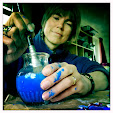Artists Tim Wootton, Howard Towll, Rhian Field, Sandy Grant, Ruth Carruthers and myself collaborated with the RSPB to publicise the work of scientists from the "Future of Atlantic Marine Environment" project. They are finding out where seabirds go to feed, so that Government can legislate to protect these areas.
Each artist contributed two pictures. This screenprint of a shag defending its nest I finished last week in the studio, using sketches from Colonsay.
This painting of kittiwakes was made at the seabird cliffs in May. The studio work is more controlled, whilst the field work has to be produced at speed. It started raining as I was finishing this picture, and I like the texture on the cliffs made by raindrops falling on the page.
All the pictures in the exhibition will be auctioned by the RSPB later in the year.





